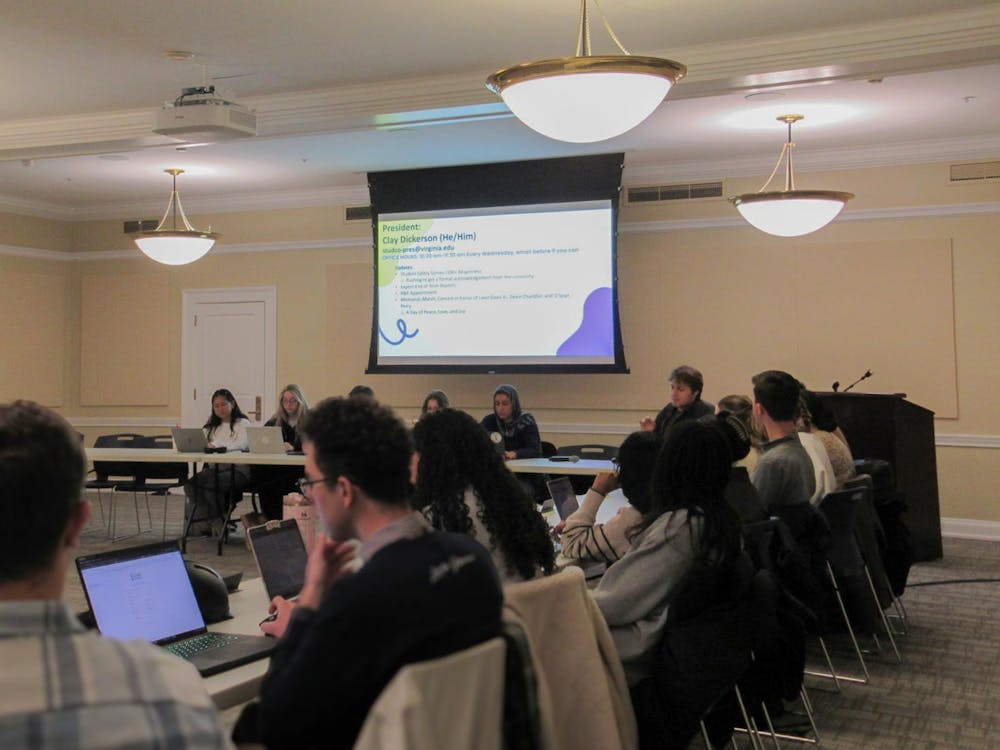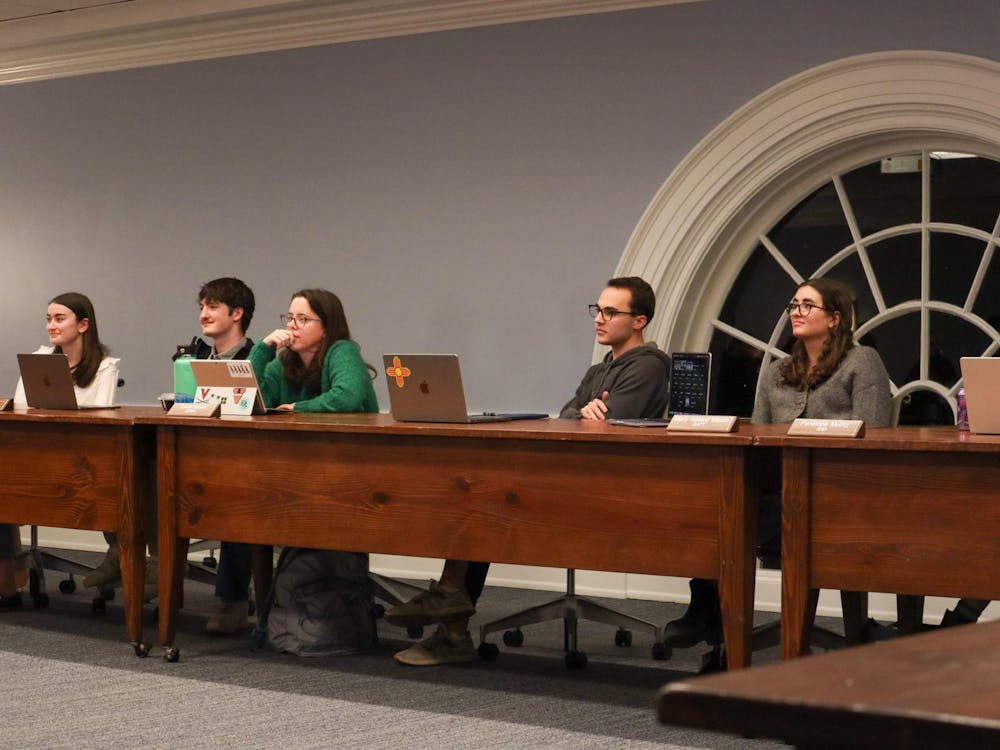It's that time of year again -- when thousands of prospective students crawl around Grounds. Every year, the University invites the thousands of admitted students to Charlottesville so they can gauge what it would be like to be a student at the University.
With Days on the Lawn, high school seniors are swarming the University. The first class to take the redesigned SAT and the first graduating class of next decade, University administrators said choosing the Class of 2010 was a long and thorough process.
The Office of Admission reviews all undergraduate applications for admission.
By the Numbers
The University admitted 36 percent of all applicants, according to Dean of Admissions Jack Blackburn. Overall, 6,5111 students applied from in-state, and the University extended admission offers to 2,762 of them. Meanwhile, 9,756 out of state students applied, and only 3,035 were accepted.
About one third of admitted University students are from out of state, one third is from Northern Virginia and one third are from other areas of Virginia, most notably the Tidewater region and the greater Richmond area in central Virginia. By law, two-thirds of University students must be from Virginia.
The most heavily populated and economically vibrant region of the Commonwealth, Northern Virginia accounts for nearly half of the class of 2010's in-state student offers of admission, Blackburn said. He added that the admissions office does not favor students coming out of any specific region's schools, such as the Fairfax County Public Schools system which has received national acclaim, but rather reflects the demographics of the state.
Regional trends regarding admission tend to remain relatively stable year to year, so Blackburn said he expects the make up of the Class of 2010 to mirror the rest of the University.
Not-So Standard Standardized Testing
One element of the admissions process that varied across the American college system was the implementation of the new SAT.
Blackburn said the new SAT didn't really alter the admissions process at the University.
"With all the tests students take, whether it is the SAT or the ACT, it's not terribly different," Blackburn said.
The differences between the new and old verbal sections are minimal, Blackburn said, and the new verbal section did not yield drastically different results from last year's applicants.
"The new verbal section is very much like the old verbal," Blackburn said. Studies have indicated that there is about a 93 percent correlation between students' scores on the old SAT and scores on the new SAT
Another difference between the newer SAT and the original SAT was the addition of the writing section, which is similar the SAT II writing test, Blackburn said.
"The new writing section is very similar to the SAT II writing test that students used to take in order to gain admission," he said.
He added that, since it is a new factor, the admissions process didn't have a range in mind.
Blackburn said the University has never been bound by the SAT as an absolute tool for admission and uses a holistic approach to admissions.
The College of Arts and Sciences
The College of Arts and Sciences is the largest school of the University's undergraduate programs, with a wide array of majors and disciplines that fall under the CLAS umbrella. Therefore, Arts and Sciences applicants make up the bulk of students in the admissions process.
Assistant College Dean Richard Handler said the College and admissions are two separate administrative units that function independently, so the faculty has a limited ability to provide input into the admissions process.
Handler said the faculty of the College has been pleased with admissions and has a great deal of confidence in the job they do.
In the past, there has been some outside pressure on the Office of Admissions to alter their process.
Handler cited previous faculty and administrative efforts to increase the number of students with an interest in hard sciences, as one such example. It is uncertain whether or not this push had undue influence on the admissions process, he added.
The Office of Admissions tries "to follow the lead of the president and the general culture of the place, but we don't have any regular meetings with them to say what it is we want," Handler said.
Overall, the group of students that comes to the University each year is excellent, he said.
"In general, University students are very good students, so, as a faculty member, you don't usually have trouble getting a good class and teaching good students," he said.
The Engineering School
The Commonwealth of Virginia has outlined goals for the University and, as a result, the admissions process for the Engineering School was slightly different this year. Dean Jim Aylor said the school is trying to increase the number of students by thirty.
The small increase in the in the class in 2010 from the class of 2009 is part of an overall plan to boost the student body of the Engineering school by a total of 200 students, Aylor said.
The University has pledged to increase the total student body by approximately 1500 students as part of a proposed Higher Education Restructuring agreement with the Commonwealth, and the Engineering school is set to absorb some of that increase, he added.
"We plan to steadily increase the pool to meet the new goal by increasing the class sizes by approximately 30 this year and then again each subsequent year," Aylor said.
Making Virginia's public universities more responsive to the state's need for more engineers has emerged as a leading goal of negotiators from the state legislature and governor's office in the restructuring talks.
Admitting a greater number of students has in no way negatively altered the admissions standards for the school.
"There has never been a shortage of excellent applicants," he said "In fact, this year's applicant pool has gone up from last year's by ten percent."
In fact, by admitting a greater number of students, the school will generate more revenue and allow for the hiring of more professors.
Hiring more professors will increase the amount of research conducted by the Engineering School, which administrators hope will vaunt the school towards its goal of being ranked among the top 20 nationally, Aylor said.
The Nursing School
Theresa Carroll, assistant dean of the Nursing School, said the admissions numbers for the Nursing School will be representative of the admissions process at the University as a whole.
Three-hundred and seventy students applied, and the Nursing School extended 75 offers in the hopes of building a class of 56, Carroll said.
Of those students offered admission, 50 percent of out of state students will accept their offers, whereas 85 percent of in-state admitted students are expected to accept their offers, she added.
The other offers were extended during the early admissions cycle.
Like the Engineering School, Carroll said the Nursing School extended more acceptances to incoming students this year.
The Nursing School is growing the class from 48 students this year to 56 students next year, Carroll said.
The ongoing construction of a new Nursing school building, ground was broken on the project over the weekend, is one of the reasons the school is able to accommodate more students, Carroll said
Carroll said the Nursing School admissions process is much like that of other schools in that it seeks students who meet the academic standards of the University.
However, she added, nursing is a career that mandates a passion or calling for the work, and any extracurricular work in health science is weighed heavily.
Most of the Nursing School's students have significant outside medical experience as emergency medical technicians or licensed nursing assistants, she said, demonstrating commitment to the field.
The Architecture School
Architecture Prof. Bill Sherman said he is pleased with the Office of Admissions.
The Office of Admissions has "done awfully well in the past, so I hope it continues," Sherman said.
The Architecture School's student body brings with it a whole range of backgrounds and skills, which is expected to continue with future classes, he added.
The Architecture School has taken steps to increase its competitiveness and applicant pool through different programs.
While many students in the Architecture School have already decided that they want a career in architecture, there are some students that are scared off by programs that commit them permanently to architecture at an early stage, Sherman said.
The Architecture School's "Four plus two" program has students earn a four-year bachelor's degree and then have the option of going on to a 2-year master's program in architecture, Sherman said.
A lot of architecture programs are intensive five-year programs that allow students to earn bachelor's and master's degrees but require an early commitment, he added.
This program has helped with the Architecture admissions process by increasing the applicant pool, because students don't necessarily feel locked into one choice, Sherman said.
"This does keep the profession open to a broad range of people," he added.
People to People
The University held its second Day on the Lawn Monday. Admitted students took University student-led tours and could sit in on various classes.
Sara Strunk, co-director of Days on the Lawn this year and third-year College student, said her experience with this year's program has given her a positive outlook about the incoming class.
"They all just seemed really enthusiastic and very excited to be at U.Va.," Strunk said. "They all seemed surprisingly engaging and not intimidated."
She said from her overall brief encounter with the admitted students of the Class of 2010, they seemed very concerned about student activities and student life.
"It's amazing how concerned they are about getting involved," Strunk said. "We had a lot of questions about student activities and student life."
She said one student's father was already inquiring about how his son could live on the Lawn.
"They were a very proactive [group] and very gun ho," Strunk said. "You'd think they'd be coming here a week from now and not just deciding [whether or not to come to the University]."






